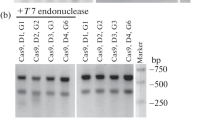Abstract
We have isolated several non-leaky mutant Chinese hamster ovary (CHO) cell clones (M4, M19, and M21) requiring cholesterol and unsaturated fatty acid for growth. These mutants belong to the same complementation group as the mutant M1 cells previously reported from this laboratory. M19 cells reverted to lipid prototrophy at very low frequency and were chosen as recipients to perform DNA-mediated gene-transfer experiments using total human genomic DNAs. Biochemical characterization of these transfectant clones indicated that, unlike their parental M19 cells, they were able to exhibit activation of cholesterol biosynthesis and LDL receptor expression in response to sterol removal from the growth medium. RNA blotting analysis indicated that these transfectants were able to increase HMG-CoA synthase gene transcripts in response to sterol removal. From the genomic DNAs of a representative secondary transfectant cell, we cloned a unique human DNA fragment (designated as hλ2) and showed that hλ2 is closely linked with the presumptive human M1 gene.
Similar content being viewed by others
Literature Cited
Goldstein, J.L., and Brown, M.S. (1990).Nature 343:425–430.
Chang, T.Y. (1983). InThe Enzyme Vol. 16, (ed.) Boyer P.D. (Academic Press, New York), pp. 491–521.
Lenard, S., and M. Sinensky. (1988).Biochim. Biophys. Acta 47:101–112.
Metherall, J.E., Goldstein, J.L., Luskey, K.L., and Brown, M.S. (1989).J. Biol. Chem. 264:15641–15643.
Panini, S.R., Lutz, R.J., Wenger, L., Miyake, J., Leonard, S., Andalibi, A., Lusis, A.J., and Sinensky, M. (1980).J. Biol. Chem. 265:14118–14226.
Edwards, P.A., and Fogelman, A.M. (1990). InCurrent Opinion in Lipidology, Vol. 1, (Current Science, London), pp. 136–139.
Rudney, H., and Panini, S.R. (1993). InCurrent Opinion in Lipidology, Vol. 4, (Current Science, London), pp. 230–237.
Russell, D.W. (1992).Cardiovasc. Drugs Ther. 6:103–110.
Briggs, M.R., Yokoyama, C.K., Wang, X.W., Brown, M.S., and Goldstein, J.L. (1993).J. Biol. Chem. 268:14490–14496.
Osborne, T.F., Bennett, M., and Rhee, K. (1992).J. Biol. Chem. 267:18973–18982.
Spear, D.H., Kutsunai, S.Y., Correll C.C., and Edwards, P.A. (1992).J. Biol. Chem. 267:14462–14469.
Wang, X.W., Briggs, M.R., Hua, X., Yokoyama, C.K., Goldstein, J.L., and Brown, M.S. (1993).J. Biol. Chem. 268:14497–14504.
Chin, J., and Chang, T.Y. (1981).J. Biol. Chem. 256:6304–6310.
Chin, J., and Chang, T.Y. (1982).Biochemistry 21:3196–3202.
Limanek, J.S., Chin, J., and Chang, T.Y. (1978)Proc. Natl. Acad. Sci. U.S.A. 75:5452–5456.
Evans, M.J., and Metherall, J.E. (1993).Mol. Cell Biol. 13:5175–5185.
Urlaub, G., Mitchell, P.J., Kas, E., Chasin, A. A., Funanage, V.L., Myoda, T.T., and Hamlin, J. (1986).Somat. Cell Mol. Genet. 12:555.
Chang, T.Y., and Chang, C.C.Y. (1982).Biochemistry 21:5316–5323.
Kreiger, M., Martin, J., Segal, M., and Kingsley, D. (1983).Proc. Natl. Acad. Sci. U.S.A. 80:5607–5611.
Cadigan, K.M., Heider, J.G., and Chang, T.Y. (1988).J. Biol. Chem. 263:274–282.
Davidson, R.L., O'Malley, K.A., and Wheeler, T.B. (1976).Somat. Cell Genet. 2:271–280.
Dillela, A.G., and Woo, S.L.C. (1985).Focus 7:1–3.
Wigler, M., Pellicer, A., Silverstein, S., Axel, R., Urlaub, G., and Chasin, L. (1979).Proc. Natl. Acad. Sci. U.S.A. 76:1373–1376.
Wigler, M., Sweet, R., Sim, G.K., Wold, B., Pellicer, A., Lacy, E., Maniatis, T., Silverstein, S., and Axel, R. (1979).Cell 16:777–785.
Hasan, M.T., Subbaroyan, R., and Chang, T.Y. (1991).Somat. Cell Mol. Genet. 17:513–516.
Southern, P.L., and Berg, P. (1982).J. Mol. Appl. Genet. 1:327–341.
Sambrook, J., Fritsch, E.F., and Maniatis, T. (1989). Molecular Cloning: A Laboratory Manual, 2nd ed. (Cold Spring Harbor Laboratory, Cold Spring Harbor, New York).
Feinberg, A.P., and Vogelstein, B. (1983).Anal. Biochem. 132:6–13.
Chang, C.C.Y., Doolittle, G.M., and Chang, T.Y. (1986).Biochemistry 25:1693–1699.
Goldstein, J.L., Basu, S.K., and Brown, M.S. (1983).Methods Enzymol. 8:241–260.
Gil, G., Brown, M.S., and Goldstein, J.L. (1986).J. Biol. Chem. 261:3717–3725.
Nudel, U., Zakut, R., Shani, M., Neuman, S., Levy, Z., and Yaffe, D. (1983).Nucleic Acid Res. 11:1759–1771.
Correa-Rotter, R., Mariash, C.N., and Rosenberg, M.E. (1992).Biotechniques 12:154–158.
Korenberg, J.R., and Rykowski, M.C. (1988).Cell 53:391–400.
Cadigan, K.M., Chang, C.C.Y., and Chang, T.Y., (1989).J. Cell Biol. 108:2201–2210.
Author information
Authors and Affiliations
Rights and permissions
About this article
Cite this article
Hasan, M.T., Chang, C.C.Y. & Chang, T.Y. Somatic cell genetic and biochemical characterization of cell lines resulting from human genomic DNA transfections of Chinese hamster ovary cell mutants defective in sterol-dependent activation of sterol synthesis and LDL receptor expression. Somat Cell Mol Genet 20, 183–194 (1994). https://doi.org/10.1007/BF02254759
Received:
Accepted:
Issue Date:
DOI: https://doi.org/10.1007/BF02254759




